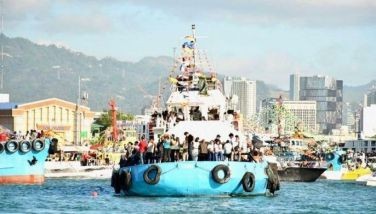Filipino book discoveries

I have rediscovered these past few days that long weekends are great for reading books; and, that there are still so many Philippine published books that are great readings. Here are two discoveries on my reading journey during the recent Undas holidays.
LINEAGE, VISION, EMPIRE: Don Francisco “Paquito” Ortigas Jr. by Alfredo Yuson, Reyes Publishing 2018 .
The story of the Ortigas clan is, in most parts, a story that parallels Philippine history over the past century and a half. The book focuses on the life of Francisco Ortigas Jr; but, it begins with the historical tale of the beginning of the Ortigas clan in the Philippines.
It was March 1861 when Spanish Captain Ignacio Ortigas arrived in this country. Seven years later, he married Asuncion Barcinas y Tuason and had three sons. The youngest was Francisco “ Paco” Ortigas born Sept. 11, 1875. Although he became a well-known lawyer, it was Don Paco’s venture into real estate that made him well known. He formed a partnership that arranged the purchase of Hacienda de Mandaloyon, which was originally part of the estate holdings of the Augustinian Order. The property covered an area of 4,033 hectares which spanned the municipalities of the present Mandaluyong, San Juan, Pasig and Quezon City. Some of his original partners included Manuel Quezon and Vicente Madrigal.
According to the book: “When Ortigas & Co. took over management of the estate, it was a virtual wasteland. It was the vision of the management team, headed by Atty. Francisco ‘Paquito’ Ortigas Jr. who was president and chairman at that time, that transformed this wasteland into a progressive industrial, commercial and residential urban complex.” Paquito Ortigas was the second of seven children who took over Ortigas & Co., at the age of 30, When his father died in 1935. According to Fernando M. Ortigas, the book’s executive publisher:
“Rare are sons who surpass the greatness of their fathers. Such a one was Don Francisco ‘ Paquito’ Ortigas Jr.”
This 12-chapter book is full of anecdotes, copies of correspondence, and striking photos including one of an oil painting by Amorsolo of Paquito Ortigas. While the book focuses on his successes in business, law and even public service, there are parts that talk about the personal side – like his passion and excellence in sports and oratory during his schooldays in De La Salle.
My favorite part of the book is Chapter 11 – Remembering Don Paquito: Other Voices – which was the result of interviews with family members about their personal memories. For example, one family member said: “Even as a busy man, he often took me to movies, after lunchtime such as for Singing in the Rain. He also used to take me to football games, especially when La Salle was playing at the Rizal Memorial Field. He had been a terrific football player himself.”
He read philosophers and poets and habitually put down his thoughts on paper. Don Francisco “Paquito” Ortigas Jr. passed away on Feb. 2, 2003 at 96 years of age. The last entry in his diary was a prayer for his family, his country and for humanity especially the poor.
OCCUPATION: 1942-1945 by Benito Legarda Jr., published by Vibal Foundation, 2016.
This book is a collection of columns written by Legarda on accounts of the day to day lives of ordinary Filipinos during the Japanese Occupation. It presents not just a Filipino perspective but a nationalist view of the Second World War.
For example he writes about the Battle of Bataan: “How had Bataan played its role? It had stopped the veteran Japanese army cold in its track for three months with an army that was 85 percent Filipino composed of farm boys. laborers, students, mountain tribesmen and reserve officers half trained and ill equipped and berefit of air support...In round numbers, the figures given by historian Stanley Falk are that the USAFFE numbered 78,000 on April 3, composed of 66,000 Filipinos and 12,000 Americans.”
The Bataan Death March is another part of Philippine history that Legarda writes about. He estimates that around 600 Americans and between 5,000 to 10,000 Filipinos perished during the Death March.
The book has exceptional stories on ordinary Filipinos during that period. He writes about Ireneo G. Dagot whose schooling reached only the 4th grade and worked as a stevedore at Cuyo, Palawan. In November 1941, at the age of 20 he was called to active duty for training in Canlubang, Laguna. He was in the Battle of Bataan, survived the Death March and spent time in prison in Capas. He was almost killed in Bataan, suffered from malaria and dysentery, and was hungry and sick most of the time. He was finally released and made his way back to Cuyo. After the war, he went back to Manila, became a driver and settled down in Antipolo. Legarda writes: “There is nothing spectacular in his story, which really consists of taking one’s post and doing one’s duty when the country calls.”
Legarda also has several stories about Filipino guerrillas including the two major guerrilla victories against the Japanese – the Battles of Ipo Dam and Bessang Pass. Toward the end of the book, he writes about the battle to liberate Manila and its effects on the civilian population. The massacare at La Salle College is a well known story. Lesser known are similar stories of massacres that happened in St. Paul’s College, Concordia College, German Club, Perez-Rubio residence. Nicanor Reyes household, Masonic Temple-Paco, and in Intramuros. In his preface, Legarda writes: “The present void in our knowledge of this crucial period to our history distorts our national perspective and stunts our sense of nationhood. Historical amnesia inevitably leads to national disorientation. This we cannot afford in this increasingly complex and hazardous world.”
Creative writing classes for kids, teens and adults
Young Writers’ Hangout on Nov. 10 with Grace Chong and 24 with DM Reyes (1:30pm-3pm; stand-alone sessions), writing in the workplace with Ginny Santiago on Nov. 17 (1:30-4:30 pm) at Fully Booked BGC. For details and registration, email [email protected].
* * *
Email: [email protected]
- Latest
- Trending

























